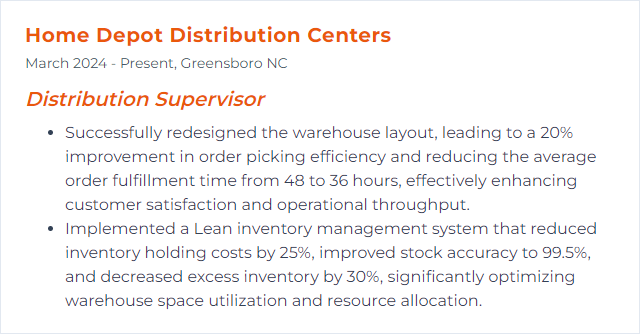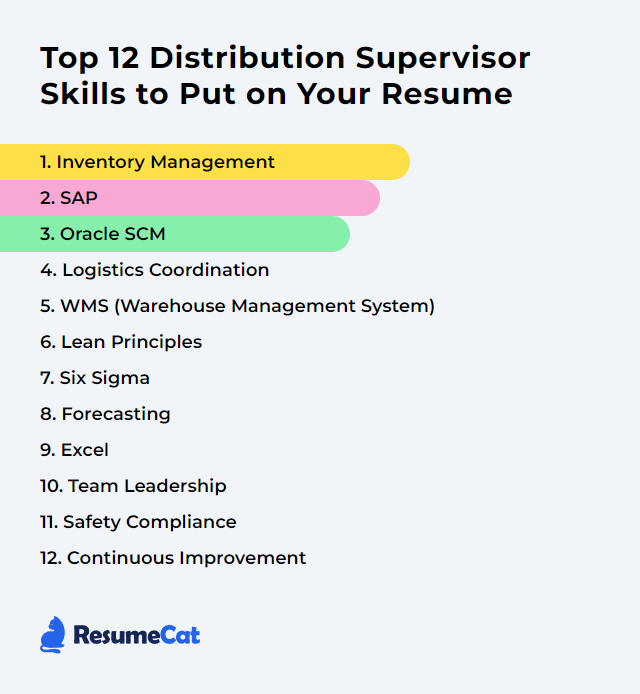Top 12 Distribution Supervisor Skills to Put on Your Resume
A strong resume for a Distribution Supervisor should mix operational know-how with decisive leadership. Show what you can run, fix, and improve. Make it specific to the job you want so your skills pop against the noise in a crowded field.
Distribution Supervisor Skills
- Inventory Management
- SAP
- Oracle SCM
- Logistics Coordination
- WMS (Warehouse Management System)
- Lean Principles
- Six Sigma
- Forecasting
- Excel
- Team Leadership
- Safety Compliance
- Continuous Improvement
1. Inventory Management
Inventory management means controlling how stock is ordered, stored, picked, and shipped so the right items are available at the right time without locking up cash or space. In distribution, speed and accuracy rule; your job is to keep both steady.
Why It's Important
It keeps product on hand, waste low, and customers happy. Done well, it trims carrying costs and prevents stockouts or overages that jam operations.
How to Improve Inventory Management Skills
Focus on process, data, and people—tight and practical:
Use a real-time system: Centralize stock, orders, receipts, and adjustments so counts reflect the floor, not guesses.
Run lean: Set min/max levels, apply 5S in storage areas, and stage fast-movers close to shipping.
Forecast with evidence: Blend history, seasonality, and promotions; review exceptions weekly and adjust quickly.
Tune supplier cadence: Share demand signals, set clear lead times, and agree on backup plans for spikes or constraints.
Cycle count relentlessly: High-value and high-velocity SKUs first; investigate variances the day they appear.
Train for accuracy: Standard work for receiving, putaway, picking, and returns. Measure adherence, coach gaps.
Segment SKUs: ABC analysis for attention and space; safety stock for volatile items, not everything.
Do these consistently and inventory stops being a fire drill and turns into a dial you can set.
How to Display Inventory Management Skills on Your Resume

2. SAP
SAP is an ERP platform that ties together purchasing, inventory, warehouse, and order fulfillment. For supervisors, it’s the hub for movements, counts, and service levels.
Why It's Important
It streamlines orders, improves visibility, and reduces manual touches. Which means fewer errors, faster turns, and cleaner reporting.
How to Improve SAP Skills
Improve the setup, the workflows, and the user habits:
Align configuration to reality: Storage types, putaway rules, picking strategies, and tolerance settings should match how your floor actually runs.
Adopt SAP EWM and SAP IBP where appropriate: EWM for advanced warehouse controls; IBP for planning and replenishment. Retire old APO planning where feasible.
Automate routine tasks: Batch jobs for backorders, replenishment, and label generation. Use barcoding and scanners everywhere.
Integrate cleanly: Ensure tight interfaces with TMS, WMS (if separate), and carrier systems to remove double entry.
Use analytics: Standard dashboards for fill rate, pick accuracy, dock-to-stock time, and labor productivity. Schedule them; act on them.
Simplify with SAP Fiori: Role-based tiles and guided screens reduce clicks and training time.
Close the loop: Run user feedback sessions monthly; fix pain points fast and document new standards.
How to Display SAP Skills on Your Resume
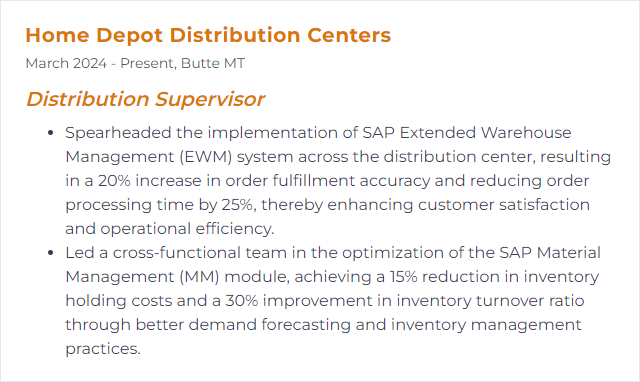
3. Oracle SCM
Oracle Fusion Cloud SCM is a suite that manages planning, procurement, inventory, manufacturing, and logistics. Supervisors use it to control stock, orders, and warehouse activity with real-time visibility.
Why It's Important
It connects demand, supply, and fulfillment. That alignment cuts cost, boosts service, and speeds decisions.
How to Improve Oracle SCM Skills
Turn knobs that actually move the needle:
Train the team deeply: Role-based training for receiving, putaway, picking, and shipping. Short refreshers beat long one-offs.
Lean on automation: Use replenishment policies, exception alerts, and guided picking to reduce touches.
Tune inventory policies: ABC segmentation, safety stock for volatile items, and clear reorder points. Review quarterly.
Collaborate upstream: Share forecast changes with suppliers; set SLAs and measure them.
Stay current: Apply quarterly cloud updates after testing. New features often replace workarounds.
Configure for your flows: Receiving tolerances, lot/serial controls, and cross-docking rules should fit your products and customers.
Measure and iterate: Track fill rate, backorder volume, dock-to-stock, and pick accuracy. Fix the bottleneck you can prove.
How to Display Oracle SCM Skills on Your Resume

4. Logistics Coordination
It’s the orchestration of inbound, storage, and outbound. Trucks, docks, people, and time—lined up so orders land where they should, when they should.
Why It's Important
Good coordination shrinks delays, trims freight spend, and lifts customer confidence. Bad coordination does the opposite, loudly.
How to Improve Logistics Coordination Skills
Tighten communication: Clear pre-arrival notices, dock appointments, and status updates. Short standups beat long emails.
Use the right tools: Transportation management systems, real-time tracking, and barcode scanning. Visibility prevents surprises.
Optimize routes and schedules: Route optimization for last mile; dynamic re-slotting for wave changes.
Standardize exceptions: Define what happens when trucks are late, orders change, or inventory is short. Scripts reduce chaos.
Train and cross-train: Flex the team across receiving, picking, packing, and shipping to absorb swings in demand.
Review performance data: On-time arrivals, dwell time, tender acceptance, and claims. Improve one metric at a time.
How to Display Logistics Coordination Skills on Your Resume
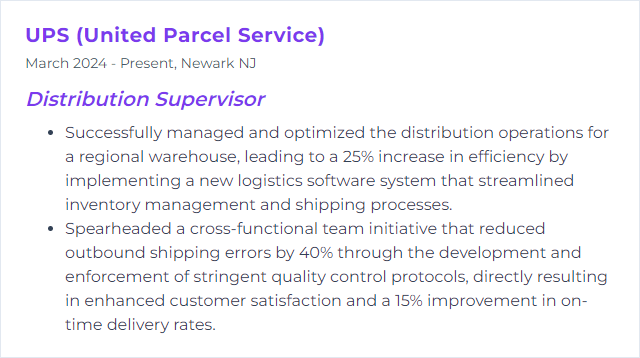
5. WMS (Warehouse Management System)
A WMS controls the heartbeat of the warehouse—receiving, putaway, slotting, picking, packing, and shipping—so labor, space, and inventory work together instead of colliding.
Why It's Important
It lifts accuracy, speeds fulfillment, and helps you deploy labor where it counts. Costs fall, service rises.
How to Improve WMS (Warehouse Management System) Skills
Go real-time: Scanners, RFID, or IoT where it makes sense. Transactions should post as the work happens.
Integrate upstream and down: Solid interfaces with ERP, TMS, carriers, and automation equipment remove rekeying and lag.
Engineer the layout: Slot by velocity and affinity, shorten pick paths, and separate fast lanes from slow movers.
Automate smartly: Consider put-to-light, pick-to-light, AMRs, or conveyors after fixing process waste. Tech amplifies discipline.
Use advanced picking: Wave, batch, zone, or cluster picking—choose based on order profiles and monitor hit rates.
Maintain relentlessly: Updates, backups, and device health checks. Downtime is expensive.
Train and document: SOPs with screenshots, quick reference guides, and floor coaching. New hires should be productive fast.
Mine the data: Heatmaps, travel time, pick rates, and error codes. Fix the outliers, then the trends.
How to Display WMS (Warehouse Management System) Skills on Your Resume

6. Lean Principles
Lean cuts waste and pushes value forward. In distribution, that means cleaner flow, fewer touches, and errors that fade into the background.
Why It's Important
Lean lowers cost, raises speed, and steadies quality. It’s how you do more with the same four walls.
How to Improve Lean Principles Skills
Define value: What matters to your customers—speed, accuracy, damage-free—make that your north star.
Map the value stream: Draw every step. Remove steps that don’t add value. Shrink the rest.
Create flow: Balance work, reduce batching, and clear blockers so orders move without stop-start drama.
Pull, don’t push: Replenish based on actual demand and signals, not hope or habit.
Chase perfection: Daily Kaizen, visual management, and problem-solving at the source. Small fixes compound.
How to Display Lean Principles Skills on Your Resume
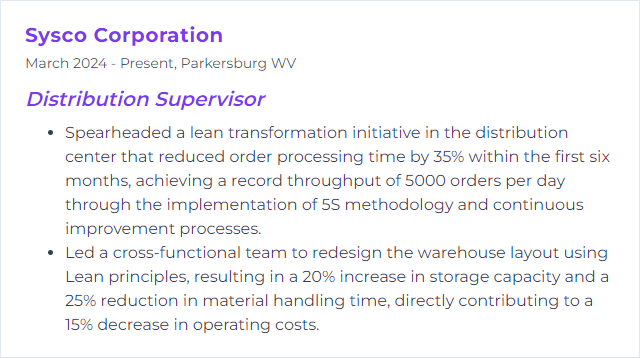
7. Six Sigma
Six Sigma uses data and the DMAIC method to crush variation and defects. The outcome: steadier processes and fewer headaches.
Why It's Important
It turns guesswork into measured improvement. Costs drop, accuracy climbs, customers notice.
How to Improve Six Sigma Skills
Learn the core tools: SIPOC, cause-and-effect, control charts, hypothesis testing. Use them, don’t just name them.
Define sharp goals: Examples—cut picking errors by 40%, reduce dock-to-stock to under 4 hours, shrink damages by half.
Measure what matters: Order accuracy, cycle time, defect rate, cost per line. Validate your measurement system.
Analyze the root causes: Pareto the defects, test assumptions with data, confirm before changing anything big.
Improve pragmatically: Standardize work, error-proof steps, rebalance labor, and re-slot SKUs where the data points.
Control the gains: Visual controls, audits, control plans, and owner assignments. Sustain or it slips.
Engage the team: Short huddles, clear charters, and shared wins. Momentum matters.
How to Display Six Sigma Skills on Your Resume
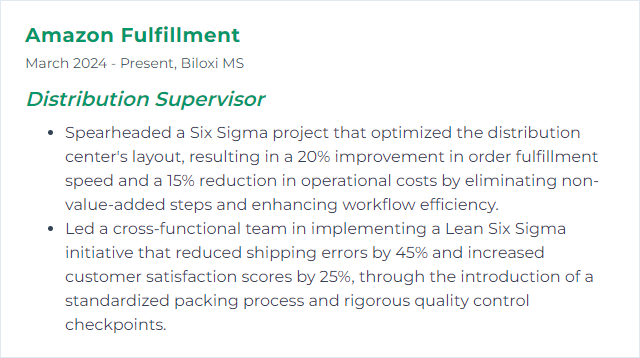
8. Forecasting
Forecasting is predicting what you’ll need on hand and when. It underpins staffing, space, and inventory decisions.
Why It's Important
Better forecasts mean fewer stockouts, less excess, and smarter routing. Misreads ripple through everything.
How to Improve Forecasting Skills
Start with clean history: Remove anomalies, mark promotions, and separate channels so your baseline isn’t noisy.
Pick the right models: Simple moving averages for stable SKUs; seasonality and trend models for the rest. Review forecast error, not just the number.
Collaborate cross-functionally: Sales, marketing, and operations must weigh in on events, launches, and end-of-life items.
Watch external signals: Lead times, macro trends, and supplier constraints. Adjust safety stock when risk rises.
Close the loop: Compare forecast to actuals weekly; refine parameters; document learnings.
Scenario plan: Build best/base/worst cases and align capacity and labor plans accordingly.
How to Display Forecasting Skills on Your Resume
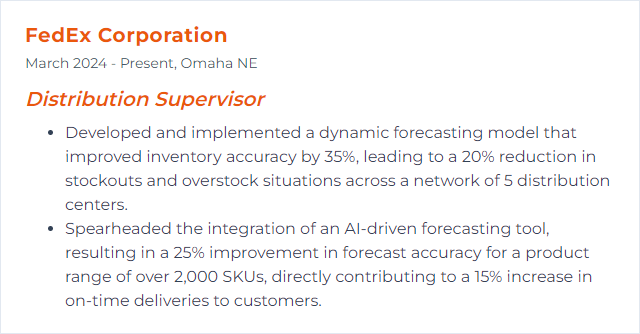
9. Excel
Excel underpins analysis, scheduling, and reporting. Quick models, fast checks, clean visuals—day after day.
Why It's Important
It lets you crunch data, spot issues early, and present options clearly. A quiet superpower on the warehouse floor and in meetings.
How to Improve Excel Skills
Upgrade your formulas: Master XLOOKUP, INDEX/MATCH, SUMIFS, COUNTIFS, IFERROR, and TEXT functions for robust models.
Own PivotTables and slicers: Summarize large data sets, drill into exceptions, and refresh reports in seconds.
Use Power Query: Clean, merge, and automate data imports from CSVs, databases, and exports without manual wrangling.
Model with Power Pivot: Build relationships and DAX measures for multi-table reporting.
Automate with macros: Record and refine VBA for repetitive tasks like report formatting or file consolidation.
Make patterns visible: Conditional formatting to flag lows, highs, and exceptions. Smart charts for trendlines and variance.
How to Display Excel Skills on Your Resume
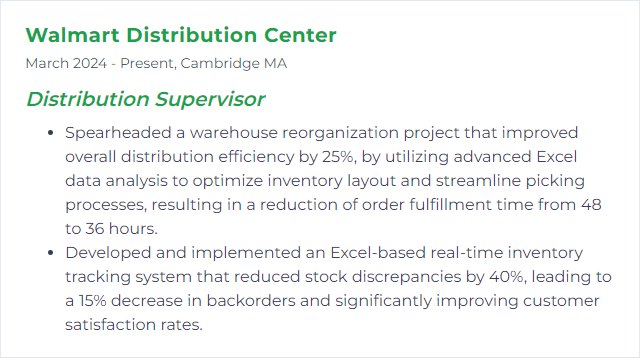
10. Team Leadership
Leadership in distribution is clarity, accountability, and pace. Set direction, remove blockers, and build a team that solves problems before they spread.
Why It's Important
Coordinated people beat chaotic talent. Productivity rises, morale stabilizes, customers feel it.
How to Improve Team Leadership Skills
Communicate simply: Define the target, the metric, and the deadline. Give feedback that’s specific and immediate.
Build trust: Be present on the floor, listen first, and follow through. Consistency beats charisma.
Plan the work: Labor planning, cross-training, and clear shift handoffs. No ambiguity at the start of a shift.
Coach performance: Set goals, track them visibly, and coach one behavior at a time. Recognize wins publicly.
Decide decisively: When trade-offs hit—cost, speed, quality—make the call and explain the why.
Develop successors: Delegate stretch tasks, rotate leads, and document playbooks. Build bench strength.
How to Display Team Leadership Skills on Your Resume
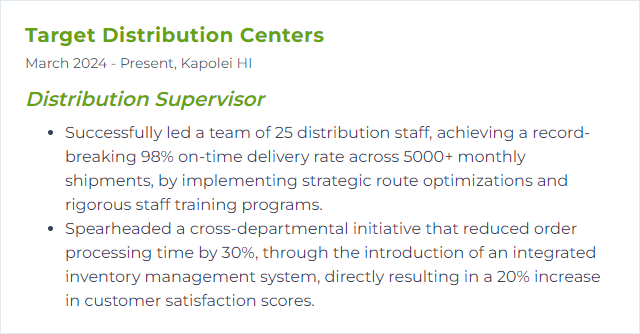
11. Safety Compliance
Safety compliance means meeting regulations and your own stricter standards to protect people and product. Policies, training, equipment, and culture—working together.
Why It's Important
It prevents injuries, fines, and downtime. More importantly, it sends everyone home in one piece.
How to Improve Safety Compliance Skills
Train continually: Role-based onboarding plus refreshers. Short, focused, and frequent.
Communicate hazards: Visual cues, toolbox talks, and open reporting channels without fear of retaliation.
Audit and act: Scheduled inspections, near-miss tracking, and fast corrective actions with owners and due dates.
Enforce clear procedures: Lockout/tagout, forklift rules, PPE use, and incident reporting—documented and enforced.
Maintain equipment: Checklists for forklifts, racking, docks, conveyors, and safety gear. Tag out immediately when needed.
Drill for emergencies: Evacuations, severe weather, spills, and first aid. Practice until it’s muscle memory.
Recognize safe behavior: Reinforce the right actions with public praise and tangible rewards.
How to Display Safety Compliance Skills on Your Resume
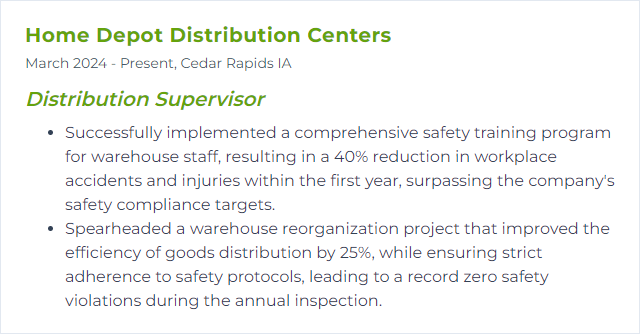
12. Continuous Improvement
Continuous improvement is the habit of making things better every week. Small changes, fast learning, tracked results.
Why It's Important
It compounds. Costs go down, speed goes up, and quality settles into a reliable groove.
How to Improve Continuous Improvement Skills
Find the vital few: Pareto your issues; focus on the handful that drive most pain.
Engage the frontline: Kaizen ideas from people doing the work beat top-down theories.
Standardize wins: When something works, lock it in with SOPs, training, and visuals.
Blend Lean and data: Use 5S, visual management, and simple metrics to guide behavior.
Leverage technology: WMS analytics, dashboards, and alerts that spotlight drift before it bites.
Track KPIs and review: Weekly cadence on service, cost, quality, and safety. Adjust quickly; avoid drift.
How to Display Continuous Improvement Skills on Your Resume
